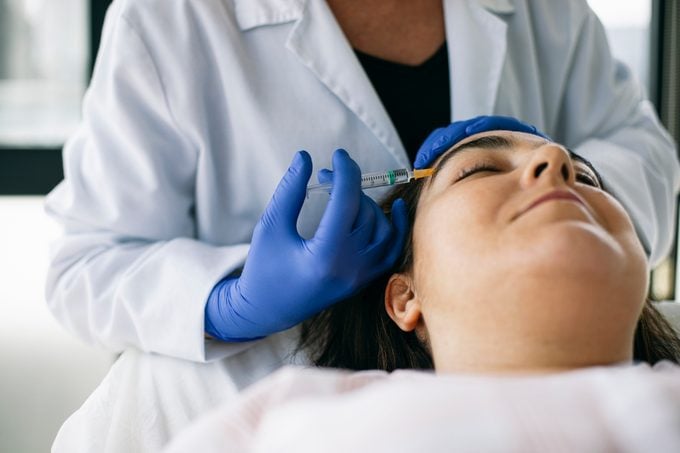Everything You Need to Know About Botox for Migraines
Updated: Dec. 01, 2021
Botox is often associated with its wrinkle-reducing benefits. But Botox has also helped millions of people who suffer from chronic migraine headaches.
The science behind Botox
Botox is derived from the same toxin (Clostridium botulinum) that causes botulism, a rare and deadly type of food poisoning that paralyzes muscles.
Years ago, scientists isolated one strain of this toxin, “onabotulinumtoxinA,” and harnessed its power for good. Now known as Botox and marketed by pharmaceutical giant Allergan, this strain relaxes “hyperactive” muscles.
In 2010, the U.S. Food and Drug Administration (FDA) approved Botox for chronic migraine treatment, after numerous studies found it to be effective.
Researchers published a defining meta-analysis on “Botulinum Toxin versus Placebo” in the journal Plastic and Reconstructive Surgery in 2019.
It examined results from 17 separate studies on migraines from the past 20 years, concluding Botox “is the first real benefit in patient quality of life.”
While the idea of toxin injections may be scary, the risks of Botox for migraines are low.
“The amount we give is a very small therapeutic dose,” explains Stephen Silberstein, MD, a professor of neurology at Thomas Jefferson University in Philadelphia.
“Used therapeutically, the doses are [extremely] lower than that which is toxic.”
Here’s everything you need to know about botox for migraines.

A migraine is more than just a bad headache
Heads ache for lots of reasons. Late nights, stress, screen time, certain foods, alcohol, and allergies are among the many reasons why people turn to pain medication for relief.
But when lights, sounds, or even simple movements send paralyzing waves of pain through your head, it may be a migraine headache.
Migraine is a neurological disorder that can affect the whole body, according to the Migraine Research Foundation (MRF). In addition to throbbing head pain, you may have periods of nausea, vomiting, visions issues or “auras,” and dizziness lasting up to 72 hours.
About 40 million people in the United States suffer from migraines. Women between the ages of 18 and 44 are three times more likely to have migraines than men.
The cause of migraines is unknown, but 90 percent of people who get migraines have a family history of migraines, according to the MRF.
Migraines may be “episodic” and occur occasionally. Or they can be chronic, with headaches occurring more than 15 days a month (at least eight considered migraines).
Botox for migraines is a game-changer
Although there is no cure for chronic migraines, Botox is now the treatment of choice to reduce their frequency and severity. This is especially true after other treatments have failed.
“Before Botox, there were different classes of drugs—beta-blockers, anti-depressants, and anti-convulsants—all of which have systemic side effects,” Dr. Silberstein says.
“The advantage of Botox is that it works locally without these side effects.”
During a treatment session, professionals inject Botox into muscles on the face, scalp, neck, and shoulders. There it enters the nerve endings near the injection site and disrupts the pain messaging to the brain.
“In many ways, Botox is safer than other treatments for migraine [which are] associated with obesity, imbalance, sedation, and renal and gastric complications due to overuse,” says Teshamae Monteith, MD, an associate professor of clinical neurology at the University of Miami.
The most common side effect of Botox, according to Allergan, is pain or swelling at the injection site. On rare occasions, people report drooping eyes or drooling, but most side effects are temporary and subside within a few days.
There is good news for people with “episodic migraines,” for which Botox has not yet been FDA-approved. Allergan is currently researching whether “high-frequency episodic migraine headaches” may also benefit from Botox.
Botox can break the cycle of migraines
Botox injections for migraines generally occur every three months, according to Dr. Monteith. This is the national standard to keep patients from developing antibodies to the toxin.
The long span between Botox treatments also makes it easier for patients to manage their care.
“Most other medications require daily pills that people may forget to take,” Dr. Silberstein says.
According to the American Migraine Foundation, most patients report fewer headache days after Botox treatments, with maximum results generally seen by the third treatment.
For many patients, the migraines eventually go away, Dr. Monteith says, and Botox treatments taper off. For some, Botox therapy is continuous.
“[Botox] is generally not a lifelong treatment, as many get better over time,” she explains. “However, some patients may have a form of chronic migraine that worsens when treatment is stopped, so [extended] use may be needed.”
Who should avoid Botox for migraines?
While Botox may be standard for chronic migraine sufferers, it isn’t necessarily for everyone.
People with muscle or nerve conditions, such as ALS (Lou Gehrig’s disease) or myasthenia gravis, should be wary of Botox. Though the risk is small, Botox may increase the risks of difficulty swallowing or breathing for those with pre-existing neuromuscular conditions.
Pregnancy is always a consideration that should be discussed with your doctor, especially since chronic migraines are more common in women.
“While there’s no evidence that Botox should not be used in pregnant women, I don’t use it with any pregnant patients,” Dr. Silberstein notes.
Currently, the FDA has approved Botox for migraines only in adults 18 and older who have chronic migraines. Doctors may still prescribe Botox to minors “off label,” which means outside the FDA’s approved uses. Insurance companies, however, may not cover the cost.
The financial cost of Botox treatments
The FDA recommends 155 units of Botox per treatment, which can run from $300 to $600 depending on your provider. Add the doctor fees and other “tack-ons” and the annual costs for migraine management can get pricey.
Fortunately, most insurance plans cover Botox, including Medicare and Medicaid, if your doctor diagnoses you with chronic migraines.
“Before your insurance company will approve Botox as a treatment, you typically must have tried and failed to respond to two other preventative treatments for two months,” Dr. Silberstein explains.
For migraine sufferers who do not meet the criteria, Allergan offers a “Botox Savings Program” that can help lower costs.



